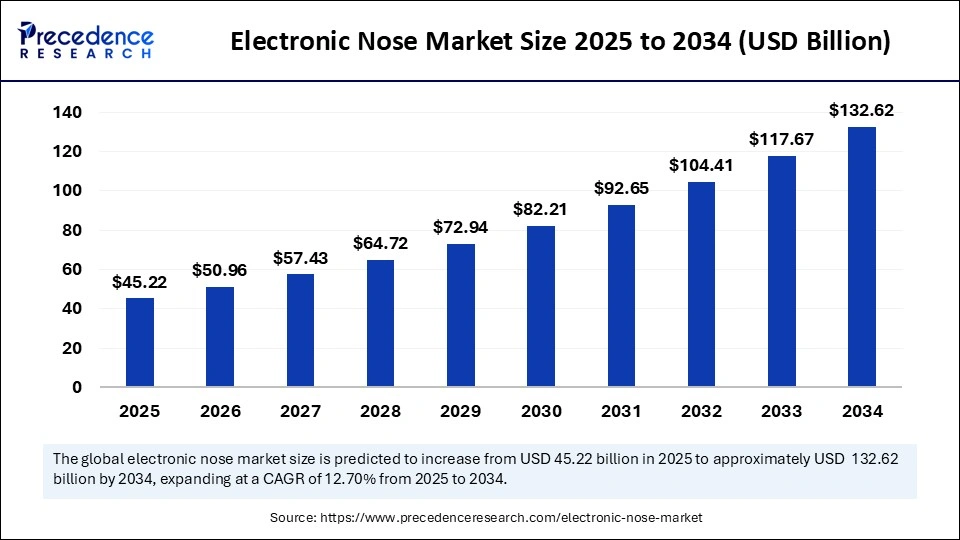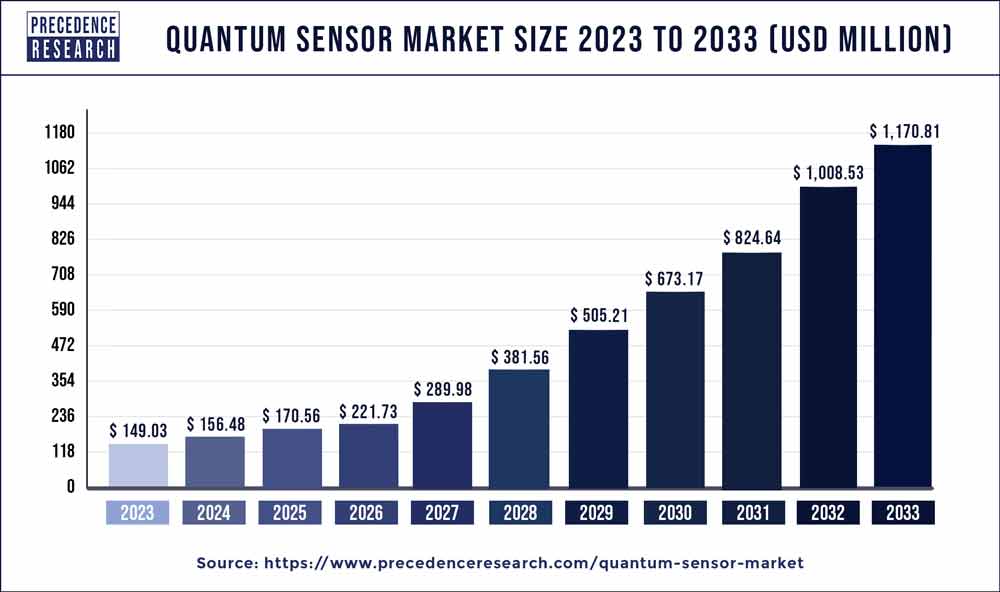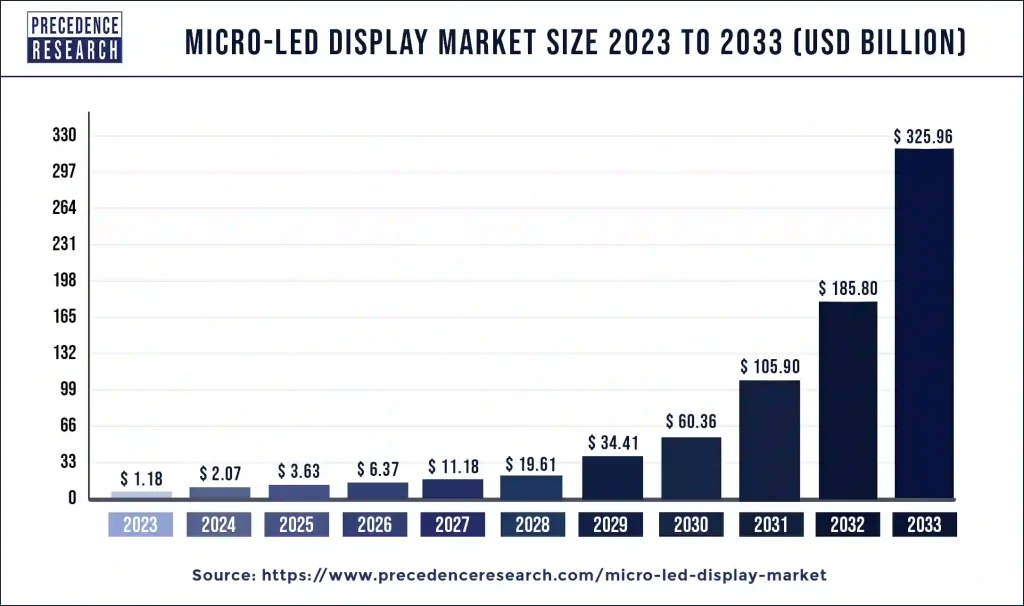
Electronic Nose Market Key Points
- North America dominated the electronic nose market with the largest market share of 35% in 2024.
- Asia Pacific is projected to experience the fastest growth in the coming years.
- By product type, the portable electronic noses segment held a dominant share of the market in 2024.
- By product type, the fixed electronic noses segment is projected to expand at a significant rate during the forecast period.
- By application, the food & beverage industry segment led the market with the largest share in 2024.
- By application, the environmental monitoring segment is projected to grow at a considerable rate during the predicted timeframe.
- By sensor technology, the metal oxide semiconductor (MOS) sensors segment held a significant share of the market in 2024.
- By sensor technology, the conductive polymer sensors segment is observed to expand at a notable rate during the projection period.
- By form factor, the compact segment captured a significant share of the market in 2024.
- By form factor, the modular segment is seen to grow at a rapid pace in the upcoming years.
Market Overview
The Electronic Nose Market is experiencing strong momentum as industries increasingly adopt advanced sensory technologies to mimic the human olfactory system for a variety of practical applications. An electronic nose, or e-nose, is an intelligent sensing device that detects and recognizes complex odors, vapors, and gases using a combination of chemical sensors and pattern recognition software. These devices are increasingly being deployed across sectors such as food and beverage, healthcare, environmental monitoring, defense, cosmetics, and industrial quality control.
The rising demand for automation, real-time analysis, and non-invasive testing across multiple sectors has fueled interest in the commercialization of electronic noses. These devices are gaining popularity not just as substitutes for human sensory panels but as more accurate, reproducible, and cost-effective solutions capable of detecting contaminants, spoilage, air quality deterioration, or specific disease biomarkers in clinical diagnostics. As technology matures and sensor accuracy improves, the market is witnessing greater interest from sectors that traditionally relied on manual or biological testing methods, thereby driving broader market expansion.
Growth Factors
The electronic nose market is being propelled by several compelling growth drivers. One of the most significant is the growing focus on food safety and quality assurance. In the food and beverage industry, e-noses are used to detect spoilage, contamination, and fermentation status, replacing time-consuming and subjective manual testing. As global food regulations tighten and consumer demand for quality increases, the use of electronic noses in quality control labs, production lines, and packaging processes is surging.
Another critical growth factor is the rising concern over air pollution and toxic gas emissions, which has led to increased deployment of e-nose systems in environmental monitoring and industrial safety. These devices help detect hazardous gas leaks or emissions in manufacturing facilities, waste treatment plants, and chemical industries, enhancing workplace safety and regulatory compliance.
In the healthcare sector, the demand for non-invasive diagnostic tools is growing rapidly, and e-nose technologies are being explored for their potential to detect diseases such as lung cancer, diabetes, and COVID-19 by analyzing breath samples. This has opened new avenues for research and commercialization, especially in personalized medicine.
Moreover, miniaturization and cost reduction in sensor technologies, coupled with advances in data analytics, are making electronic noses more affordable and adaptable for use in consumer devices, smartphones, and smart home systems, further accelerating market adoption.
Impact of AI on the Electronic Nose Market
Artificial Intelligence (AI) is revolutionizing the electronic nose market by significantly enhancing its core functionality—pattern recognition. Traditional electronic noses relied on statistical models or basic algorithms to interpret sensor data, but modern e-noses powered by AI and machine learning can process complex odor signatures more accurately and reliably.
One major application of AI is in training the e-nose to recognize and differentiate among thousands of odor patterns with high precision. Machine learning models, particularly convolutional neural networks (CNNs) and deep learning algorithms, can be trained on vast datasets of chemical signatures to improve sensitivity, specificity, and adaptability of the e-nose in varied environmental conditions.
AI also enables real-time anomaly detection, making e-noses highly effective in safety-critical environments like chemical plants or hospitals. AI systems can continuously monitor gas concentrations and instantly identify deviations from normal thresholds, triggering automated alerts or shutdowns.
Furthermore, AI-integrated e-noses are enabling breakthroughs in medical diagnostics by analyzing volatile organic compounds (VOCs) in breath to detect disease biomarkers. These systems learn from thousands of breath samples to build models that can diagnose diseases earlier and with less invasiveness than traditional methods.
In addition, AI is aiding in predictive maintenance of the devices themselves, ensuring long-term performance stability and reducing downtime by forecasting sensor degradation and calibration needs.
Market Scope
| Report Coverage | Details |
| Market Size by 2034 | USD 132.62 Billion |
| Market Size in 2025 | USD 45.22 Billion |
| Market Size in 2024 | USD 40.12 Billion |
| Market Growth Rate from 2025 to 2034 | CAGR of 12.70% |
| Dominating Region | North America |
| Fastest Growing Region | Asia Pacific |
| Base Year | 2024 |
| Forecast Period | 2025 to 2034 |
| Segments Covered | Product Type, Application, Sensor Technology, Form Factor, and Region |
| Regions Covered | North America, Europe, Asia-Pacific, Latin America, and Middle East & Africa |
Market Drivers
Several key drivers are contributing to the rapid expansion of the electronic nose market:
-
Stringent food safety regulations and quality control requirements, particularly in developed economies.
-
Growing demand for real-time air quality and pollution monitoring due to rising industrialization and urbanization.
-
Surging interest in non-invasive medical diagnostics, where breath analysis using e-nose technology offers promising potential.
-
Increased automation and digitization across industries, driving the integration of intelligent sensing technologies.
-
Improved affordability and performance of sensor arrays and embedded systems, enabling broader commercial use.
Opportunities
The electronic nose market offers a wealth of emerging opportunities:
-
Integration into consumer electronics and smart home systems, where e-noses can detect spoiled food, gas leaks, or indoor air pollutants.
-
Deployment in precision agriculture, for monitoring soil conditions, plant health, and environmental stress through volatile emissions.
-
Expansion into defense and security, where e-noses are used to detect explosives, narcotics, or chemical warfare agents.
-
Collaborations between healthcare institutions and tech companies to develop AI-driven breath diagnostic platforms for early disease detection.
-
Development of portable and wearable e-nose devices, opening up applications in fitness, health tracking, and environmental sensing.
Challenges
Despite the promise, the electronic nose market faces several notable challenges:
-
Sensor drift and calibration issues over time, which can affect the reliability and repeatability of measurements.
-
High cost and technical complexity of advanced e-nose systems, particularly in industries with tight margins.
-
Limited standardization and regulatory frameworks for odor analysis, especially in healthcare and environmental sectors.
-
Difficulty in replicating the full complexity of the human olfactory system, which limits the range and subtlety of odors an e-nose can detect.
-
Concerns around data privacy and ethical use, particularly in medical or consumer applications involving health data and biometric information.
Regional Outlook
North America is currently the leading market for electronic nose technologies, thanks to the presence of advanced healthcare infrastructure, strong investment in R&D, and a high degree of automation in manufacturing and food processing industries. The U.S., in particular, is at the forefront of deploying e-noses in medical diagnostics and environmental monitoring.
Europe holds a significant market share as well, with countries like Germany, the UK, France, and the Netherlands promoting e-nose adoption in food safety, industrial compliance, and air quality regulation. The European Union’s strong environmental legislation continues to drive adoption in waste management and industrial sectors.
Asia-Pacific is poised for the fastest growth, driven by rapid industrialization, expanding healthcare access, and growing environmental concerns in countries like China, India, Japan, and South Korea. Rising pollution levels and growing food safety scandals are creating strong demand for odor detection and gas monitoring technologies.
Latin America, the Middle East, and Africa represent emerging markets where adoption is in earlier stages but is expected to accelerate as technology costs decline and applications expand into agriculture, food processing, and public health.
Electronic Nose Market Companies

- WAGEM Monitoring Systems
- Tiger Nose Associates
- Cyranose
- SPEC Sensors
- Odotech
- Owlstone Medical
- Bedfont
- eNose Company
- Aryballe Technologies
- Cambridge Sensotecs
- Delphian Corporation
- Aethon
- Airsense Analytics
- Alpha MOS
- Smiths Detection
- Ionicon Analytik
Segments Covered in the Report
By Product Type
- Portable Electronic Noses
- Fixed Electronic Noses
- Handheld Electronic Noses
By Application
- Food & Beverage Industry
- Medical & Healthcare Industry
- Environmental Monitoring
- Defense and Security
- Industrial Manufacturing
By Sensor Technology
- Metal Oxide Semiconductor (MOS) Sensors
- Polymer Sensors
- Conductive Polymer Sensors
- Surface Acoustic Wave (SAW) Sensors
- Piezoelectric Sensors
By Form Factor
- Compact
- Modular
- Integrated
By Region
- North America
- Europe
- South America
- Asia Pacific
- Middle East and Africa
Also Read: Pass by Noise Testing Market
Get this report to explore global market size, share, CAGR, and trends, featuring detailed segmental analysis and an insightful competitive landscape overview @ https://www.precedenceresearch.com/sample/6086
You can place an order or ask any questions, please feel free to contact at sales@precedenceresearch.com|+1 804 441 9344

